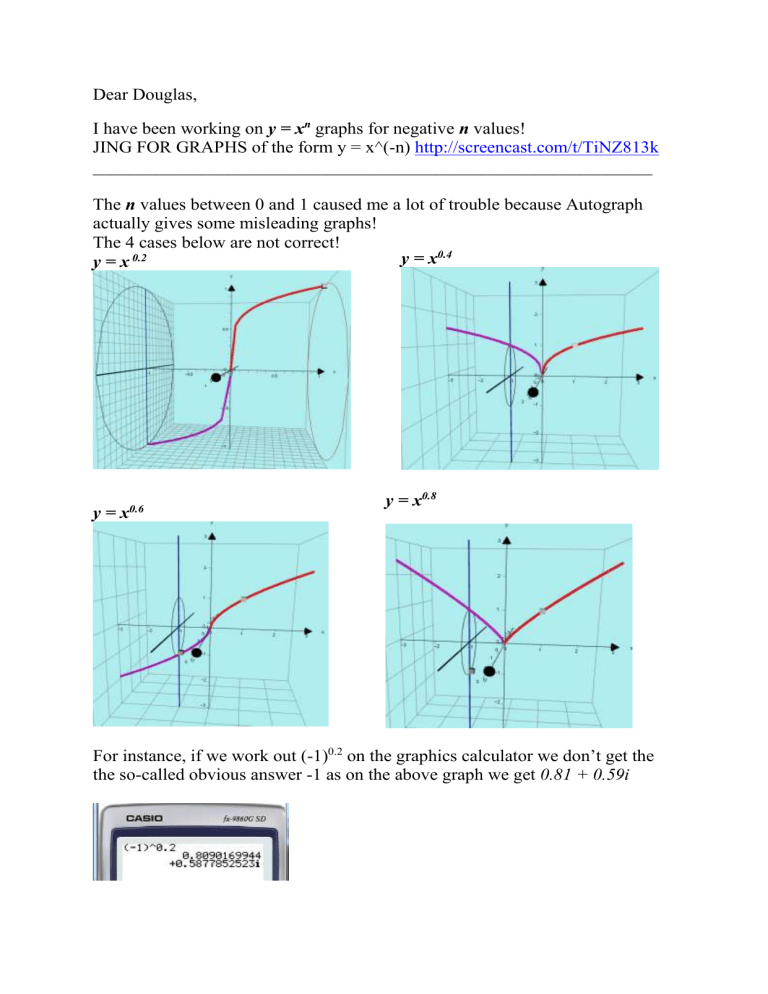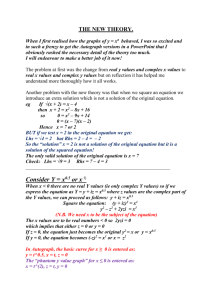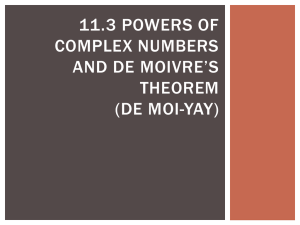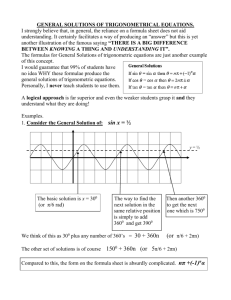Theory - TSM Resources

Dear Douglas,
I have been working on y = x n graphs for negative n values!
JING FOR GRAPHS of the form y = x^(-n) http://screencast.com/t/TiNZ813k
______________________________________________________________
The n values between 0 and 1 caused me a lot of trouble because Autograph actually gives some misleading graphs!
The 4 cases below are not correct! y = x 0.2 y = x 0.4 y = x 0.8 y = x 0.6
For instance, if we work out (-1) 0.2
on the graphics calculator we don’t get the the so-called obvious answer -1 as on the above graph we get 0.81 + 0.59i
When I worked out a few points I realised the proper phantom is as shown below in BLUE :
The algebra needed to find the actual phantom equations is really difficult but it is easy if I stick to the powers 0.25, 0.5 and 0.75.
_______________________________________________________________
Consider y = x 0.2
= 𝒙
𝟏
𝟓 which only has 1 solution just as 9 ½ = +3 not -3 as well.
If we raise this to the power 5 we get y 5 = x
Solving y 5 = +1 for instance, we get 5 solutions and so 5 curves on the right hand side above in RED (only 1 shown)
Solving y 5 = -1 for instance, we get 5 solutions and so 5 curves on the left hand side. The BLUE and PURPLE ones above are just 2 of them.
Because I can’t find the proper equations, I just did a version using vectors to illustrate the point.
All these are solutions of y 5 = -1
By De Moivre’s Theorem:
( r cis(θ) ) 5 = –1
r 5 cis(5θ) = 1cis( 180 + 360n) r 5 = 1 and 5θ = 180 + 360n r = 1 and θ = 36 + 72n
= 36 0 , 108 0 , 180 0 , 252 0 , 324 0 x
1
= 1cis(36 ) = 0.81 + 0.59i x
2
= 1cis(108) = –0.31 + .95i x
3
= 1cis(180) = –2 the only real sol. x
4
= 1cis(252) = – 0.31 – .95i x
5
= 1cis (324) = 0.81 – 0.59i
The Primary Solution is x
1
= 0.81 + 0.59i
The equation y 5 = -1 is not the same as y = (−𝟏)
𝟏
𝟓 y 5 = -1 has 5 solutions but y = (−𝟏)
𝟏
𝟓 only has 1 solution in the same way that y 2 = 9 has 2 solutions y = +3 and -3 but y = 9 ½ only has 1 solution y = +3
So that
𝟓
√−𝟏 𝒐𝒓 (−𝟏)
𝟏
𝟓
=
0.81 + 0.59i which is verified by the graphics
calculator. (It does not = -1)
_______________________________________________________________
NB The working for powers 0.5, 0.25, ⅓ and 0.75 follows:
Consider Y = x 0.5
or x ½
When x < 0 there are no real Y values (ie only complex Y values) so if we express the equation as Y = y + iz = x 0.5
where z values are the complex part of the Y values, we can proceed as follows: y + iz = x 0.5
Square the equation: (y + iz) 2 = x 1
y 2 – z 2 + 2yzi = x 1
(N.B. We need x to be the subject of the equation)
The x values are to be real numbers < 0 so 2yzi = 0 which implies that either z = 0 or y = 0
If z = 0, the equation just becomes the original y 2 = x or y = x 0.5
If y = 0, the equation becomes (-z) 2 = x 1 or x = z 2
In Autograph, the basic curve for x ≥ 0 is entered as: y = t^0.5, x = t, z = 0
The “phantom y value graph” for x ≤ 0 is entered as: x = t^(2), z = t, y = 0
The graph in 3D is as shown.
To help me check the validity of what I was doing I used my graphics calculator to find the Y value when x = – 1
Y = (– 1) 0.5
= 0 + i
P
See point P in the diagram on the left
This graph is remarkably similar to the graph of y = x 2 and its phantom in the
“normal” phantom graph theory for real y values.
NORMAL ORIENTATION
The difference of course is that x = y 2 is a full parabola but y = x ½ is only the top half of the parabola since the power ½ does not mean y = ±√x
It is more obvious when rotated.
Q
Q
P P
If we use y = x ½ and calculate y when x = – 1 we get one solution y = +i as in the graph on the left. The graph on the right would imply that y = +i or – i
The extra solution appears because we squared the original equation.
Consider Y = x 0.25
or x ¼
When x < 0 there are no real Y values (ie only complex Y values) so if we express the equation as Y = y + iz = x 0.25
where z values are the complex part of the Y values, we can proceed as follows: y + iz = x 0.25
Square the equation: (y + iz) 2 = x 0.5
(y 2 – z 2 ) + 2yzi = x 0.5
Squaring again to get an equation in the form x = f(y,z)
so (y 2 – z 2 ) 2 – 4y 2 z 2 + i4yz(y 2 – z 2 ) = x
(N.B. We need x to be the subject of the equation for autograph)
If z = 0, the equation just becomes the original y 4 = x or y = x 0.25
If y = 0, the equation becomes z 4 = x so x = z
If y = ± z, the equation becomes -4z 4 = x
0.25
By squaring the equation TWICE we introduce more non valid solutions!
The situation is very similar to the case of y = x 4 in the “normal” theory of
Phantom Graphs.
Y = x 4 Rotated version of y = x 4
P
Q
The graph of Y = x 0.25
is below:
Q
By squaring the equation twice we introduced a lot of extra parts to the graph.
Testing Y = (– 1) 0.25
= 0.7 + 0.7 i
P
The graph above has 4 values for
(see black dots above) x = -1
The graph on the left shows the only valid parts of the graph where P is at the point:
x = - 1, Y = 0.7 + 0.7i
Autograph equations for red curve are y = t^.25, x = t, z = 0
Autograph equations for purple phantom are y = t, z = t, x = −4t ⁴
Consider Y = x 0.333
or x
⅓
When x < 0 there are no real Y values (ie only complex Y values) so if we express the equation as Y = y + iz = x
⅓ where z values are the complex part of the Y values, we can proceed as follows: y + iz = x
⅓ x = (y + iz) 3 = y 3 – 3yz 2 + i( 3y 2 z – z 3 )
If Im(x) = 0 then 3y 2 z – z 3 = 0 or z(3y 2 – z 2 ) = 0
So EITHER z = 0 producing the original equation y = x
⅓
or x = y 3
OR 3y 2 = z 2 so x = y 3 – 3yz 2 = y 3 – 3y(3y 2 ) = – 8y 3
Notice this is just the same as a rotation of the curve y = x 3 and its phantoms:
There are 3 solutions to y = 1 by De Moivre’s Theorem: r 3 cis(3θ) = 1cis(360n) r = 1 and 3θ = 360n so θ = 0, 120, 240 x
1
= cis(0) = 1 x
2
= cis(120) = – 0.5 + 0.866i x
3
= cis(240) = – 0.5 – 0.866i
Also there are 3 solutions of y = –1 by De Moivre’s Th: r 3 cis(3θ) = 1cis(180 + 360n) r = 1 3θ = 180 + 360n so θ = 60, 180, 300 x
1
= cis(60) = 0.5 + 0.866i this is the Primary solution. x
2
= cis(180) = – 1 x
3
= cis(300) = 0.5 – 0.866i
The Autograph equations for Y = x
⅓
will be:
Basic curve (RED) y = t^⅓, x = t, z = 0 for x > 0
Phantom curves (PURPLE) y = t, z = ±t√3, x = −8t³ for x < 0
2 of the above phantoms are not valid. The only valid one is the one below.
We see that there are apparently 3 values for such things as ( – 1) ⅓ ie Y
1
= 0.5 + 0.866i
Y
2
= – 1
Y
3
= 0.5 – 0.866i
But the original graph is not x = Y 3 it is Y = x
⅓
The graphics calculator gives ( – 1) ⅓ = 0.5 + 0.866i
which is the PRIMARY solution of Y 3 = – 1 obtained using De Moivre’s Theorem above.
This concept fits nicely with the fact that we always say that 9 ½ = +3 not -3 because the primary solution of x 2 = 9 by De Moivre’s Theorem is x = 3
Similarly ( – 1) 0.2
= 0.809 + 0.588i because the primary solution by De Moivre is cis(180/5) = cos36 + isin36 even though the 3 rd solution would be cis(180) = – 1
Consider Y = x 0.75
or x ¾
When x < 0 there are no real Y values (ie only complex Y values) so if we express the equation as Y = y + iz = x 0.75
where z values are the complex part of the Y values, we can proceed as follows: y + iz = x 0.75
Square the equation: (y + iz) 2 = x 1.5
(y 2 – z 2 ) + 2yzi = x 1.5
Squaring again to get an equation in the form x = f(y,z)
so (y 2 – z 2 ) 2 – 4y 2 z 2 + i4yz(y 2 – z 2 ) = x 3
(N.B. We need x to be the subject of the equation for autograph)
If z = 0, the equation just becomes the original y 4 = x 3 or y = x 0.75
If y = 0, the equation becomes z 4 = x 3 so x = z 0.75
If y = ± z, the equation becomes -4z 4 = x 3 so x = (-4) 1/3 z 4/3
Checking the Y value when x = -1 we get Y = (-1) .75
= -0.7 + 0.7i
As before this graph will have 1 branch for x > 0 and one phantom branch for x < 0
Autograph equations for red curve are y = t^.75, x=t, z=0
Autograph equations for purple phantom are y = −t, z = t, x = −(4)^(1/3)t^(4/3)
Whenever there is a choice of
±
, we check Y = (-1)^0.75 = -0.7 + 0.7i
This check shows that the phantom we obtained is the one that goes through the point x = -1, Y = -0.7 + 0.7i
as on
Shown in the correct sequence:
Y = x 0.25 Y = x 0.5
diagram left.
Y = x 0.75
Y = x 1











